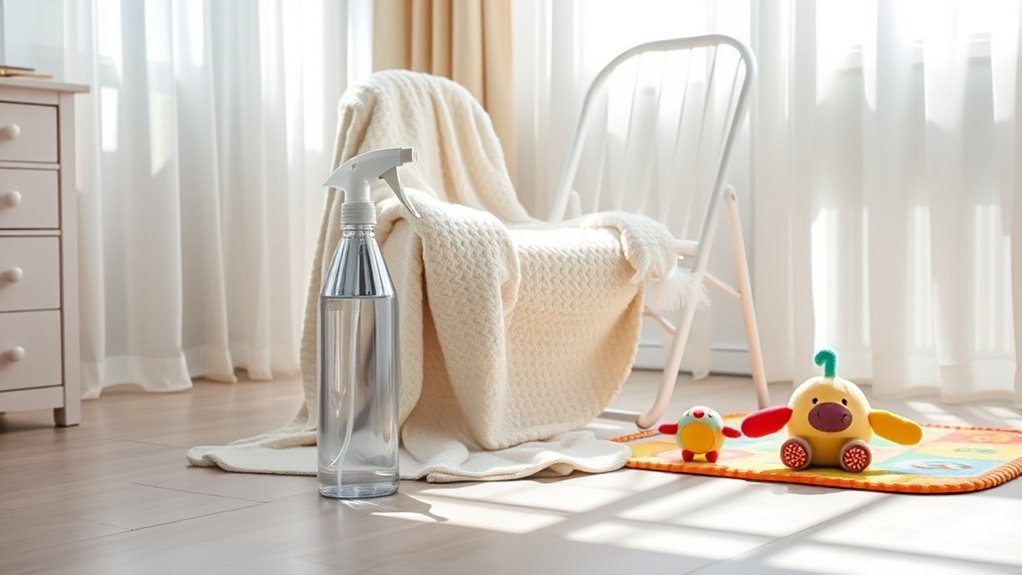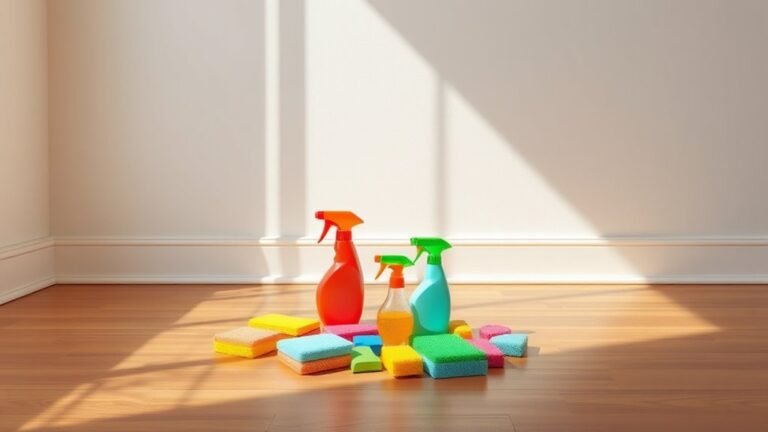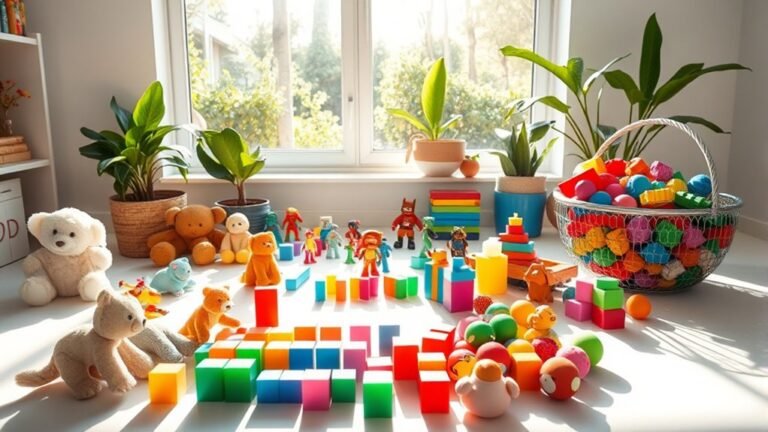Disinfecting High-Touch Areas in Baby Items
To keep your baby safe, focus on disinfecting high-touch areas like stroller handles, car seat buckles, feeding bottles, pacifiers, and toys regularly. Use gentle, non-toxic cleaners such as diluted vinegar or baby-safe disinfectants to protect their sensitive skin. Clean these items with warm, soapy water, then sterilize by boiling or using steam sterilizers. Air-dry them thoroughly to prevent mold. Establishing this routine helps reduce germs effectively. For more detailed tips on cleaning and maintaining a germ-free space, keep exploring these strategies.
Identifying High-Touch Areas on Baby Items
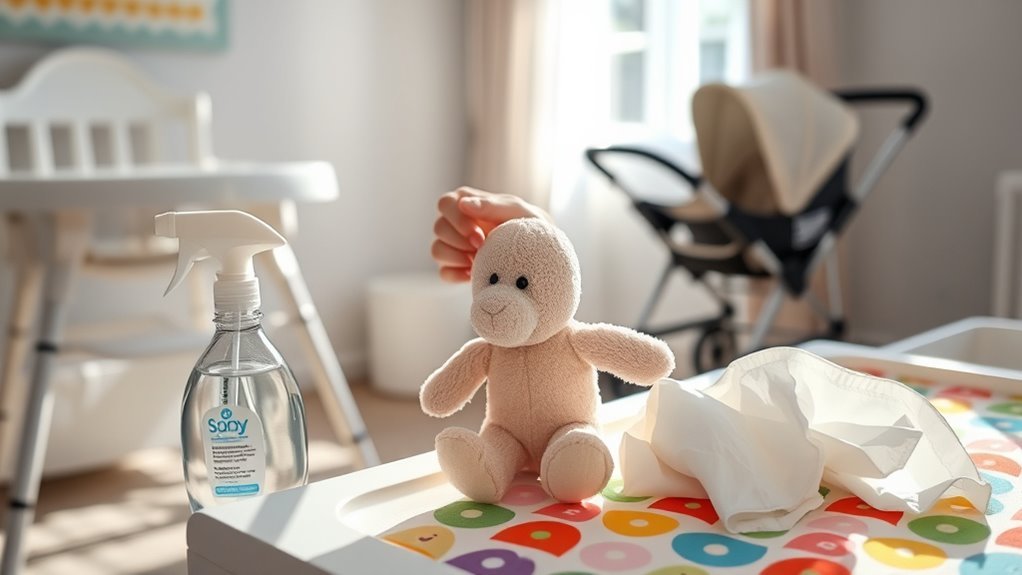
Before you start disinfecting, it’s important to identify the high-touch areas on your baby’s items. These high touch surfaces are where germs are most likely to accumulate, so focusing on them guarantees effective cleaning. Think about the parts of your baby gear that your little one and others touch frequently—like stroller handles, car seat buckles, feeding bottles, and toy surfaces. Don’t forget items like pacifiers, changing tables, and crib rails, as these are also prime spots for contact. By pinpointing these areas, you can prioritize your cleaning efforts without wasting time or energy. This targeted approach helps keep your baby safe and healthy while allowing you the freedom to enjoy parenting without constant worry about unseen germs.
Safe and Effective Cleaning Agents for Baby Products
When cleaning baby items, it’s important you choose non-toxic ingredients that won’t harm your little one. Gentle options like diluted vinegar or baby-safe disinfectants can effectively kill germs without harsh chemicals. Let’s look at methods that keep your baby’s environment both clean and safe.
Non-Toxic Cleaning Ingredients
Choosing the right non-toxic cleaning ingredients is essential to keep your baby’s items safe and germ-free without exposing them to harsh chemicals. You want natural alternatives that effectively clean while being gentle on your little one’s skin and the environment. Simple eco friendly solutions like white vinegar, baking soda, and castile soap provide powerful cleaning without toxic residues. These ingredients break down dirt and bacteria without harsh fumes or irritants. Plus, they’re affordable and readily available, giving you freedom from expensive, chemical-laden products. When used correctly, these natural options maintain cleanliness and peace of mind, letting you focus on your baby’s well-being. Remember, choosing eco friendly solutions not only protects your family but supports a healthier planet for their future.
Baby-Safe Disinfection Methods
Although natural cleaning ingredients are great for everyday use, you’ll want to incorporate safe disinfection methods to thoroughly eliminate harmful germs from your baby’s items. To keep things both effective and gentle, consider using baby safe wipes, which are specially formulated to clean without harsh chemicals. Natural disinfectants like diluted white vinegar or hydrogen peroxide can also be excellent options—they kill germs while remaining non-toxic. When disinfecting, always follow the recommended contact times to guarantee safety and effectiveness. Avoid bleach or alcohol-based products that can irritate your baby’s sensitive skin. By choosing these carefully selected methods, you’re protecting your little one without sacrificing your peace of mind or freedom to maintain a clean, safe environment.
Step-by-Step Guide to Disinfecting Toys and Pacifiers
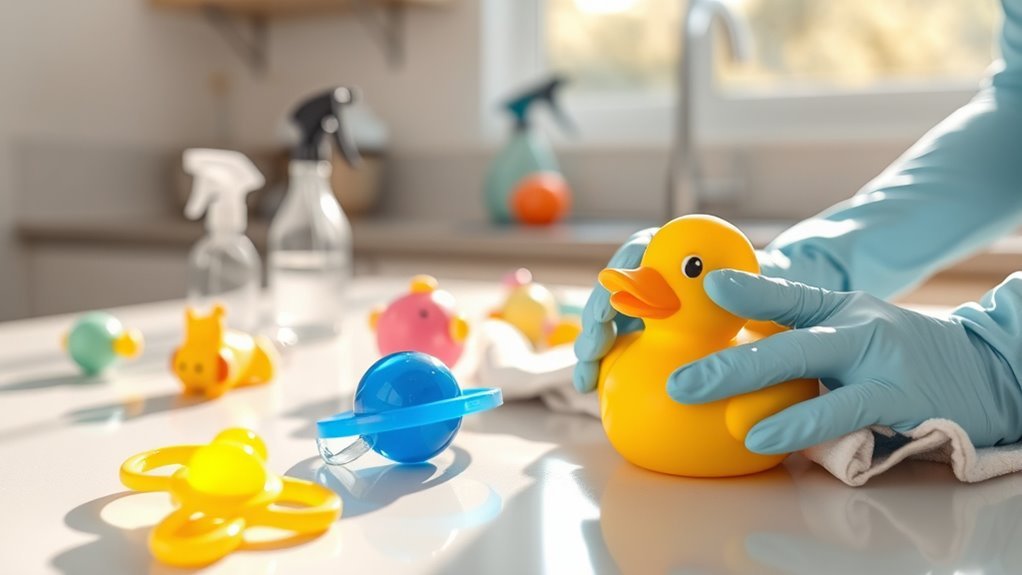
Disinfecting your baby’s toys and pacifiers regularly is essential to keep germs at bay and protect their health. To master effective toy sanitization techniques and pacifier care, follow these steps:
Regularly disinfecting your baby’s toys and pacifiers is key to preventing germs and ensuring their health.
- Clean first: Wash toys and pacifiers with warm, soapy water to remove dirt.
- Disinfect: Use a baby-safe disinfectant or boil items (when safe) for 5 minutes to eliminate bacteria and viruses.
- Dry thoroughly: Air dry on a clean towel to prevent mold and maintain hygiene.
Stick to this routine at least once a week, or more often if items fall on the floor or are shared. This approach preserves your baby’s freedom to explore safely while ensuring critical hygiene. Remember, consistent disinfecting protects your little one without restricting their curiosity.
Best Practices for Cleaning Feeding Utensils and Bottles
Keeping your baby’s feeding utensils and bottles spotless requires careful attention to detail. For ideal feeding utensil hygiene, wash all parts with warm, soapy water immediately after use, scrubbing gently to remove milk residue. Rinse thoroughly to avoid soap buildup. When it comes to bottle sterilization methods, you have several effective options: boiling for five minutes, using a steam sterilizer, or chemical sterilizing solutions designed for baby items. Choose the method that fits your lifestyle best, ensuring complete disinfection without harsh chemicals. Remember, maintaining this routine not only protects your little one from harmful bacteria but also gives you peace of mind. By prioritizing thorough cleaning and sterilization, you’re fostering a healthier feeding environment and embracing the freedom that comes with confident, safe baby care.
Disinfecting Crib Rails and Nursery Furniture
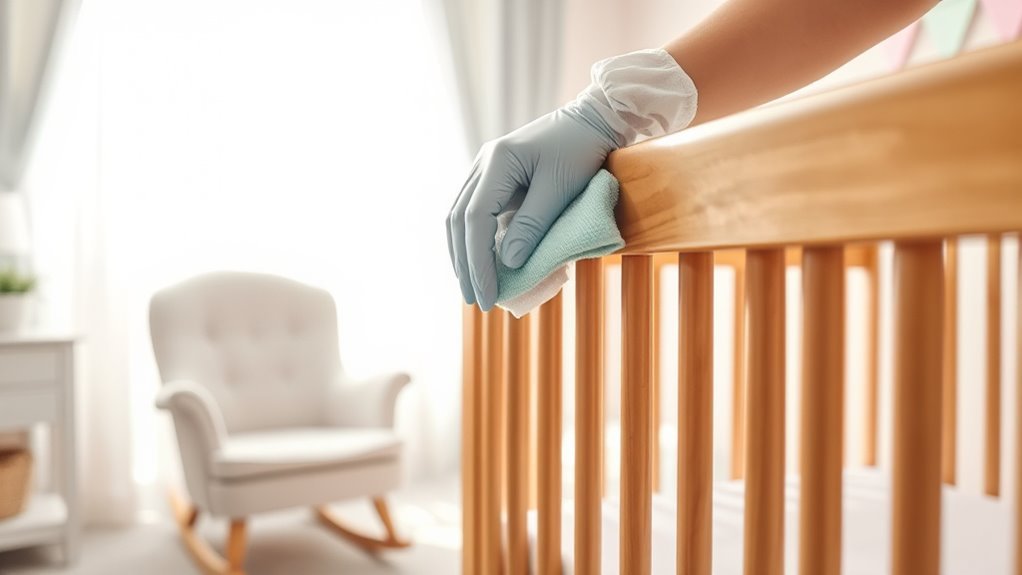
Since your baby spends so much time in their crib and nursery, ensuring these surfaces are clean and germ-free is essential for their health. When disinfecting crib rails and nursery furniture, consider the furniture materials to avoid damage. For example, wood requires gentle, non-abrasive cleaners, while metal or plastic can handle stronger disinfectants. Prioritize crib safety by using products free from harmful chemicals that might irritate your baby’s sensitive skin.
Here are key tips to keep in mind:
- Use a mild, baby-safe disinfectant suitable for the specific furniture materials.
- Wipe down all high-touch areas like crib rails, knobs, and dresser handles regularly.
- Allow surfaces to dry completely before your baby uses the crib to prevent chemical exposure.
This approach keeps your nursery clean without compromising your baby’s well-being or your freedom to choose safe products.
Tips for Maintaining a Germ-Free Environment for Your Baby
Keeping your baby’s environment germ-free starts with mastering essential cleaning techniques and choosing safe disinfectants that won’t harm their delicate health. You’ll also want to establish a consistent cleaning schedule to prevent germs from building up. These steps will help you create a safer space for your little one to explore and grow.
Essential Cleaning Techniques
Although it might seem overwhelming at times, mastering essential cleaning techniques can make a huge difference in maintaining a germ-free environment for your baby. You don’t have to be perfect, but consistent care helps keep harmful germs at bay. Start by using steam cleaning whenever possible—it’s a natural, chemical-free way to sanitize baby bottles, toys, and feeding areas. Pair this with microfiber cloths, which trap dirt and bacteria more effectively than regular fabrics. Focus on these key practices:
- Clean high-touch surfaces daily to prevent buildup.
- Rinse items thoroughly after cleaning to avoid residue.
- Air-dry baby items completely before use to inhibit bacteria growth.
Safe Disinfectant Choices
Once you’ve got the basics of cleaning down, choosing the right disinfectants becomes a key step in protecting your baby from harmful germs. You want safe, effective options that don’t introduce harsh chemicals into your home. Natural disinfectant options and eco friendly cleaners are excellent choices to maintain a germ-free environment without compromising your baby’s health or your values.
| Disinfectant Type | Benefits |
|---|---|
| Vinegar | Natural, non-toxic, antibacterial |
| Hydrogen Peroxide | Effective, breaks down quickly |
| Tea Tree Oil | Antimicrobial, natural scent |
| Eco Friendly Cleaners | Biodegradable, safe for infants |
Choosing these guarantees safety and peace of mind, letting you keep your baby’s space clean and free from harmful residues.
Routine Cleaning Schedule
Because babies are especially vulnerable to germs, establishing a consistent cleaning routine is essential for their health. You’ll want to set a practical cleaning frequency that fits your lifestyle, ensuring baby items stay germ-free without overwhelming your day. Using schedule reminders on your phone can help keep you on track, so nothing gets missed.
Consider focusing on these key areas:
- High-touch surfaces like toys and feeding utensils, cleaned daily
- Sleeping and play areas, disinfected weekly
- Bottles and pacifiers, sterilized after each use
Frequently Asked Questions
How Often Should Disinfecting Baby Items Be Done to Prevent Illness?
Wondering how often you should disinfect to keep illness at bay? The best practices suggest doing it regularly, especially after playtime or meals, to create a safer environment. You don’t want to overdo it, but maintaining a consistent routine helps prevent germs from taking hold. By balancing thorough cleaning with daily use, you’ll protect your little one’s health while enjoying the freedom of worry-free moments together.
Can Disinfecting Products Cause Allergic Reactions in Babies?
Yes, disinfecting products can cause allergic reactions in babies, especially because of certain disinfectant ingredients. Babies have delicate skin and heightened sensitivity, so harsh chemicals might trigger irritation or allergies. It’s important you choose baby-safe, gentle disinfectants specifically designed to minimize risks. Always check labels and, when possible, opt for natural or hypoallergenic options. You want to keep your little one safe without compromising cleanliness.
Are Natural Disinfectants as Effective as Chemical Ones for Baby Items?
You might wonder if natural disinfectants like essential oils or vinegar solutions are as effective as chemical ones. While these natural options can reduce some germs, they usually don’t kill as many bacteria or viruses as stronger chemical disinfectants. If you prefer natural choices, just be cautious—they might not provide full protection. Always verify the product is safe for your baby and follow usage guidelines to keep your little one healthy and happy.
Is It Safe to Disinfect Baby Items With UV Light Devices?
You might wonder about UV safety when using UV light devices to disinfect baby items. These devices can be effective at killing germs, but you need to guarantee the product is designed for baby items and used correctly. UV light can be harmful if misused, so always follow instructions carefully to avoid exposure to skin or eyes. When used properly, UV devices offer a chemical-free way to keep things clean while giving you peace of mind.
How to Disinfect Battery-Operated or Electronic Baby Toys Safely?
When wiping battery-operated baby toys, prioritize battery safety by removing batteries first to prevent moisture mishaps. With toy materials in mind, gently wipe surfaces using a damp cloth with mild soap, avoiding harsh chemicals that could damage plastics or electronic parts. Don’t soak or submerge these toys. Let them air dry completely before reinserting batteries. This careful cleaning guarantees your child’s favorite toys stay safe, sanitary, and sturdy for endless playtime freedom.
